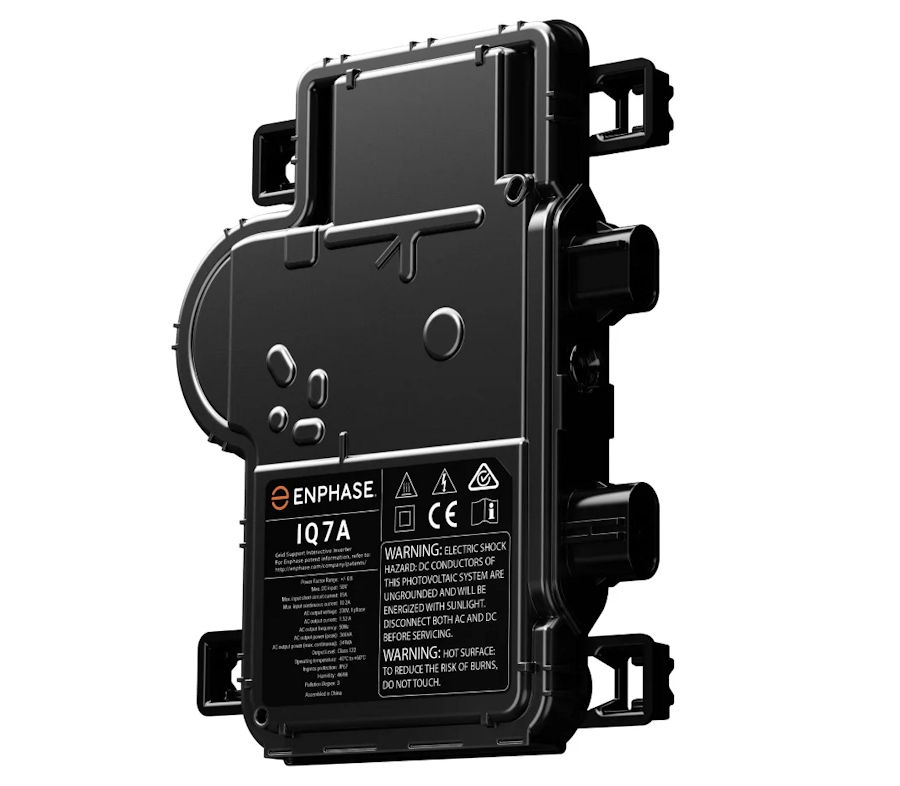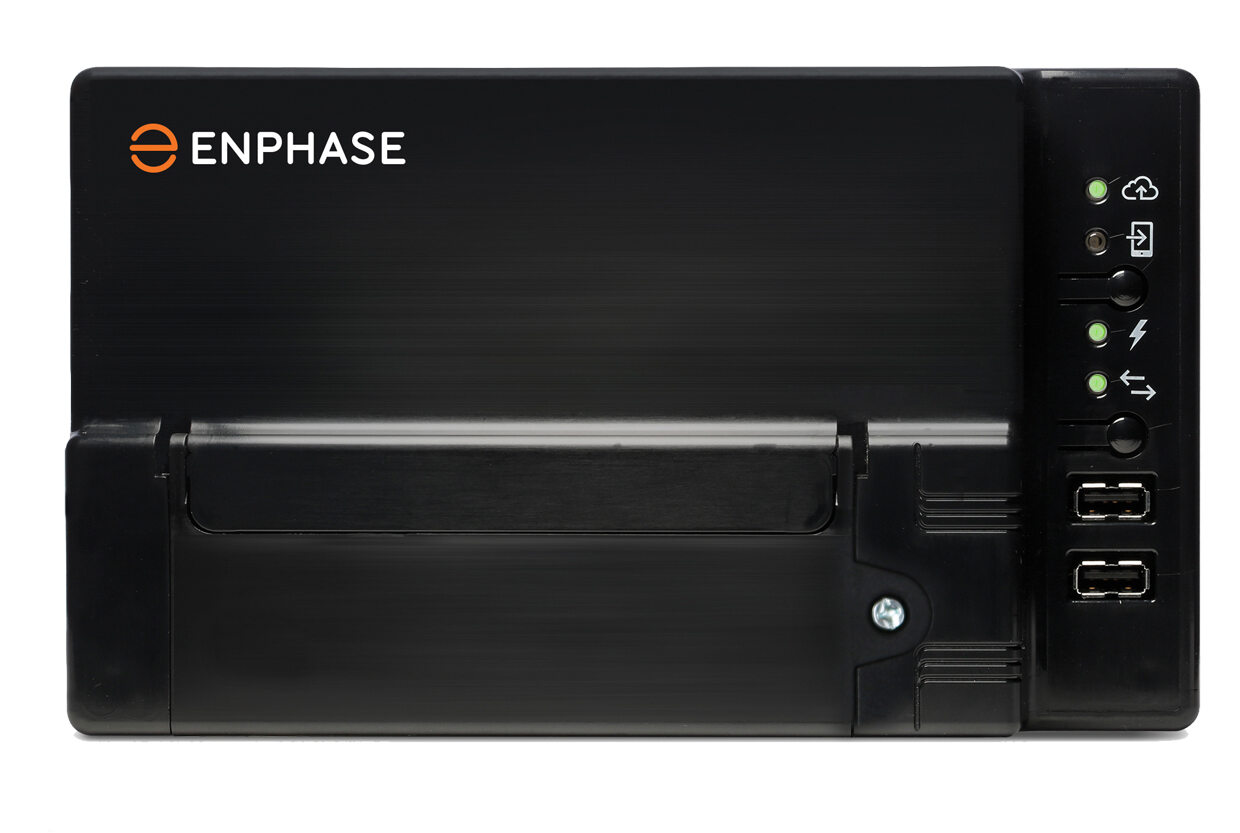Enphase Microinverters In My Solar Energy Project

The use of Enphase IQ7A microinverters in my smart home solar installation project means that each panel is generating an ac voltage, rather than a dc voltage. It allows each panel to function and be monitored independently using the Enphase Envoy hub and the Enphase Enlighten app (or the Enphase website) for monitoring. This approach also avoids shaded, damaged or failed panels having an impact on the rest of my generation capability.
As well as generating power, the microinverters communicate with an Enphase hub using powerline communications. The hub then acts as an IP gateway to my home network and the Internet.
These are the many reasons why I chose to use Enphase Microinverters in my smart home solar installation project:
- The Enphase IQ7A microinverter provides great performance with a continuous 349W output, which is a nice match for my Trina 390W panels.
- Microinverters start generating energy at lower levels of sunlight than a traditional inverter and have excellent efficiency (European weighted efficiency is 96.5%). I've have yet to experience a single day, where I have not generated energy.
- Enphase microinverters are extremely reliable and feature an excellent 25-year warranty. I have read lots of good things about them and they have been in use for many years, with extremely low failure rates.
- Microinverters will optimise the power output for each panel under all conditions. This includes shading from clouds, local structures and snow. They are the best solution for solar installations across more than one roof.
- Microinverters are ideal for my installation, which is designed to operate during power outages. The microinverters will be powered by my Tesla Powerwall and will sync with its ac supply.
- Microinverters work well with ac-coupled batteries like my Tesla Powerwall, placing no limitations on battery charge and discharge rates. They also work well with my Zappi smart EV charger.
- Unlike hybrid inverters, microinverters work in parallel with an ac coupled battery, like my Tesla Powerwall. If my solar panels are generating 6kW and the house load is higher than this, the Powerwall can deliver up to an additional 5kW (giving 11kW in total).
- Microinverters make your installation simpler and easier to control. They have no cloud dependencies once set up and simply output energy and deliver an ac voltage.
- Microinverters make an installation visually simpler and tidier in my view.
- The Enphase microinverters come with extensive monitoring to individual panel level, making diagnosis and resolution of issues really easy.
- Extending an installation using microinverters can be much simpler, as the inverter capacity increases with each panel. Newer models with higher output can also be mixed with older microinverters. Older, lower output panels and/or microinverters could also be replaced at the same time.
- Enphase microinverters are silent in operation. Some inverters can be quite noisy apparently.
- Enphase microinverters feature active power factor correction.
- Unlike many inverters, Enphase microinverters consume negligible power when there is no solar generation. Typically a standard inverter will use 60-70W even though it is not doing anything. The Envoy hub uses just 5W in standby.
- The Enphase cloud platform provides an open API to get timely generation data for smart home control and smart energy management.
The main (perceived) downside of using microinverters is the cost but, when you compare performance, features and the monitoring tools available, the cost difference is negligible in my view. I would recommend and install Enphase microinverters every time. Replacing a failed microinverter can be a more complex process, requiring scaffolding but, I'm confident this will not be an issue.
Over Sizing & Clipping
It is worth saying a few words about over sizing and clipping as it is very common practice in the UK solar industry. The 'over sizing factor' (sometimes called the over sizing ratio) is the peak output of your solar panels divided by your inverter capacity. In my installation the 17 × 390W solar panels could generate a peak output of 6.63kW under perfect conditions. In practice, the output is limited by the microinverters to 17 × 349W = 5.933kW. This results in an over sizing factor of 111.7%. Generally, it is not advisable to to exceed 130%.
The reason for over sizing is that solar panels are the relatively cheap part of any installation and they are hardly ever in the ideal conditions required to hit their peak output, due to the angle of the incident sunlight on the panels, the roof inclination, the ambient temperature, shading, etc. In the winter, the panels will not get close to their peak output due to the sun being so low in the sky. For this reason, having more panels than the inverter(s) can handle, allows you to generate more energy, more of the time.
In an ideal world, you would avoid clipping completely, so that you have the highest possible peak power to use for many things (EV charging, appliances, etc.) but, this would simply cost more and make the payback period longer. As the customer, it is entirely your choice though.
Installed Components

Our home is located in Suffolk (East Anglia, UK), one of the sunniest and driest parts of the UK. Our house faces 160° South (i.e. 20° to the East of South) and the roof is inclined at 50° and has no shading. This means it is ideally orientated for solar PV energy collection according to this orientation calculator. We have 17 Trina 390W solar panels installed, each with an Enphase IQ7A microinverter.
Enphase Envoy

Enphase microinverters are connected to the Enphase Envoy hub, which has a wired Ethernet network interface on my installation. It can use Wi-Fi though. This allows the Enphase Enlighten app to provide energy usage insights, remote update capabilities and load management.

The hub has a number of useful status and error lights on the front, which make it very easy to check that everything is working as expected.
Enphase Enlighten App
On completion of your installation, the installer will generate an email invite to download the Enphase Enlighten app. This will make your installation visible for monitoring.

The primary screen in the app is a status view, showing current power being produced and stats for today and yesterday.

People often associate microinverters (and optimisers) to installations that have partial shade but, in practice the sunlight on my panels also varies slightly as the sun comes up and goes down. This vertical variation up and down my panels can be seen on winter mornings. The microinverters ensure optimum power is delivered from each panel.

The app shows daily total energy generated per panel.
Isolation Switches
I'm assuming it is standard MCS practice but, I don't know for sure. My installer put a physical isolation switch in the loft and also put another one on the end of the cable coming down from my loft, inside my garage. They also put a fused switch inline with the power feed to the Envoy hub. This makes a lot of sense to me.
Summary
I've been amazed with the performance of my smart home solar installation project. As you can see from my data analysis, my energy generation levels are very high for a 6.63kW installation.
My system also has an exceptional Monthly Generation Factor, something I'm confident my Enphase microinverters make a big contribution to.
Further Reading
My Features
My Projects
- Smart home solar energy project
- Smart home energy modelling project
- Smart home energy management project
- Tesla Backup Gateway smart home integration project
- Energy data analysis & savings for 2022
- AC current transformer sensor
My Reviews
Off-Site Links
If you are considering moving to Octopus, you can use this referral link and Octopus will give us both £50.
- A good video explaining microinverters by Gary Does Solar
- EEVblog 1487 Do Solar Micro Inverters Take Power at Night? - a good video on why my AC current transformer sensor appears to show my Enphase microinverters using 300+W at night.
If you found this page useful you can buy me a coffee. This helps me maintain this website and add more content.




